Air quality study: assessing variations in roadside air quality with sampling height
A mobile air quality monitoring study commissioned to assess variations in roadside air quality.
4 Results
The following Sections detail the results from the study.
4.1 Mobile vs Fixed Monitoring
This section compares hourly mean concentrations of PM 2.5, PM 10, NO 2 and NO measured during the mobile monitoring exercises and compared to concentrations measured at two fixed monitoring sites located at Glasgow Kerbside and Glasgow Townhead. Orthogonal regression results between hourly mean pollutant concentrations measured at 0.80 m (LOW) and 1.68 m (HIGH) are summarised in Appendix G. Summary statistics of measured hourly average pollutant concentrations are provided in Appendix L.
4.1.1 PM 2.5
Hourly mean PM 2.5 concentrations as measured at the fixed monitoring sites, Kerbside and Townhead, and by the mobile monitoring samplers during each mobile monitoring exercise are graphed in Figure 4.1.
The minimum hourly mean PM 2.5 concentrations measured at Glasgow Townhead and Glasgow Kerbside were 0 g m -3 and 5 g m -3, respectively; during the 13 th July (Sunday) and the 9 th August (Saturday). In comparison, minimum hourly mean concentrations of PM 2.5 were measured by the mobile monitoring trolley on the 13 th July (Sunday), with a mean measured concentration of 11 g m -3, being recorded at both 0.80 m and 1.68 m respectively.
The maximum hourly mean PM 2.5 concentrations measured at Kerbside and Townhead were 23 g m -3 and 18 g m -3, respectively; during the 14 th March (Friday). The maximum hourly mean PM 2.5 concentrations measured by the mobile monitoring unit were 43 g m -3 and 40 g m -3 at 0.80 m and 1.68 m, respectively, also during 14 th March (Friday).
Over all mobile monitoring exercises, an average PM 2.5 concentration of 17 g m -3 was measured by the mobile monitoring unit at both 0.80 m and 1.68 m. A mean PM 2.5 concentration of 5 g m -3 and 12 g m -3 was measured at Townhead and Kerbside, respectively. These results show that on average, PM 2.5 concentrations were 12 g m -3 and 5 g m -3 higher travelling along the mobile monitoring route than at the Kerbside or Townhead fixed monitoring sites, respectively. The differences in concentrations of PM 2.5 reported at both fixed sites used in the study reflect the kerbside and urban background locations of these analysers, with the kerbside site located to higher emissions from road traffic.
Analysis of hourly PM 2.5 concentrations measured at 0.80 m and 1.68 m used a total of 72 hourly average data pairs with a mean absolute error ( MAE) of 0.86 g m -3 and were found to have be strongly correlated (r 2) of 0.928. No data points were rejected by the Grubbs' outlier test. Using the calculated slope of 0.920 and intercept of 1.477, at the PM 2.5 annual mean objective level of 12 g m -3 as measured as an hourly mean, comparison of concentrations at 0.80 m and 1.68 m indicate that the hourly mean PM 2.5 concentration at 1.68 m is likely to be 4% greater than that measured at 0.80 m (e.g. 12.5 g m -3). In comparison, when the maximum measured hourly mean PM 2.5 concentration of 43 g m -3 is used as the basis for comparison between the two exposure heights, the findings indicate that hourly mean concentration reported at 1.68 m is 4.7 % lower than that recorded at 0.80 m (e.g. 41 g m -3). So in general, higher hourly mean PM 2.5 concentrations were likely to be measured at adult breathing height when PM 2.5 concentrations are low. Whilst when concentrations are high, higher concentrations were likely to be measured at child breathing height.
Figure 4.1 Hourly Average PM 2.5 Concentrations Time-series - Mobile vs Fixed
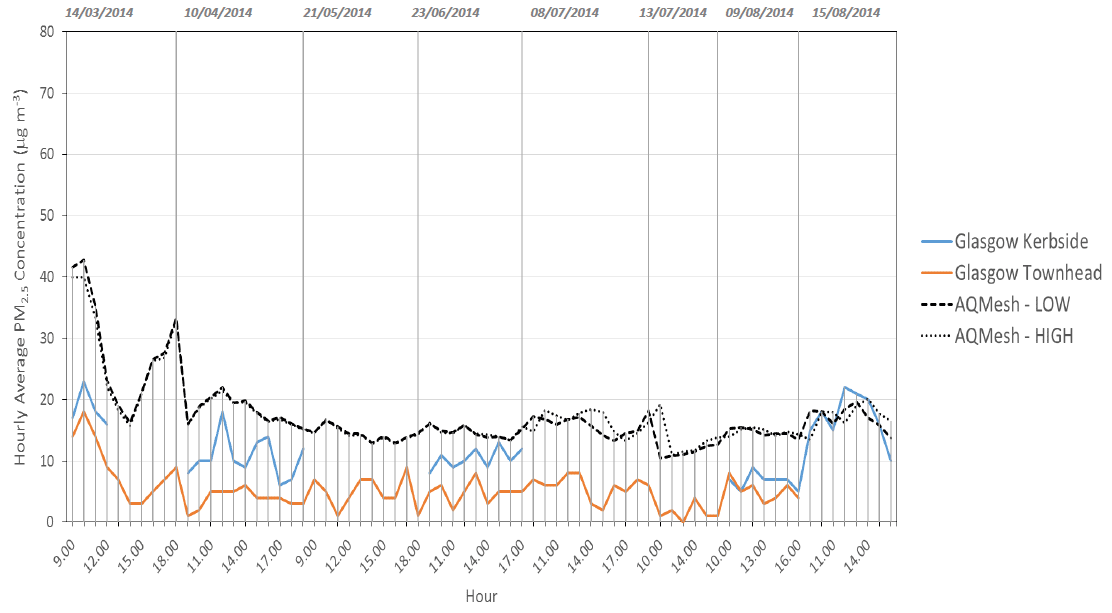
4.1.2 PM 10
Hourly mean PM 10 concentrations measured at the fixed monitoring sites, Kerbside and Townhead, and by the mobile monitoring samplers during each mobile monitoring exercise are graphed in Figure 4.2.
The minimum hourly mean PM 10 concentration measured at Kerbside and Townhead was 6 g m -3 and 3 g m -3 during the 13 th July (Sunday) and 15 th July (Saturday), respectively. The minimum hourly mean PM 10 concentration measured by the mobile monitoring unit was 2 g m -3 and 0 g m -3 at 0.80 m and 1.68 m, respectively, during the 13 th July (Sunday). The maximum hourly mean PM 10 concentration measured at Kerbside and Townhead was 41 g m -3 and 23 g m -3 measured on the 23 rd June (Monday) and 14 th March (Friday), respectively. The maximum hourly mean PM 2.5 concentration measured by the mobile monitoring unit was105 g m -3 being reported at 0.80 m and 1.68 m during the 14 th March (Friday).
Over the eight mobile monitoring exercise, mean PM 10 concentrations of 31 g m -3 and 28 g m -3 were recorded by the mobile monitoring unit at a height of 0.80 m and 1.68 m, respectively. A mean PM 10 concentration of 10 g m -3 was measured at the Townhead fixed monitoring site and 19 g m -3 at Kerbside. These results show that on average, PM 10 concentrations were 21 g m -3 and 18 g m -3 higher at 0.80 m and 1.68 m travelling along the mobile monitoring route than at the Townhead fixed monitoring site, respectively; and 12 g m -3 and 9 g m -3 higher at 0.80 m and 1.68 m travelling along the mobile monitoring route than at the Kerbside fixed monitoring site.
Comparison of concentrations of PM 10 recorded by the monitoring trolley at both exposure heights over the entire study period was undertaken using orthogonal regression. The analyses used a total of 73 hourly average data points and were recorded with a mean absolute error ( MAE) of 3.13 g m -3 and a strong correlation (r 2) of 0.964. No data points were rejected by the Grubbs' outlier test. By application of the calculated slope of 0.955 and intercept of -2.115, and using the PM 10 annual mean objective level of 18 g m -3, the analysis indicated that concentrations of PM 10 at 1.68 m are likely to be 17% lower (15 g m -3) than the concentration observed at 0.80 m (18 g m -3). Similarly, application of the same calculated slope and intercept but using the higher daily mean objective concentration of 50 g m -3 indicated that the hourly mean PM 10 concentration at 1.68 m was shown to be approximately 8% lower (46 g m -3) at 1.68 m than concentrations observed at child breathing height (0.80 m). At the maximum measured hourly mean PM 10 concentration of 105 g m -3 at 0.80 m, the calculated hourly mean concentration at 1.68 m would be 98 g m -3; 7% lower than at the lower exposure height. Therefore in general, higher hourly mean PM 10 concentrations were observed at child breathing height.
Figure 4.2 Hourly Average PM 10 Concentrations Time-series - Mobile vs Fixed
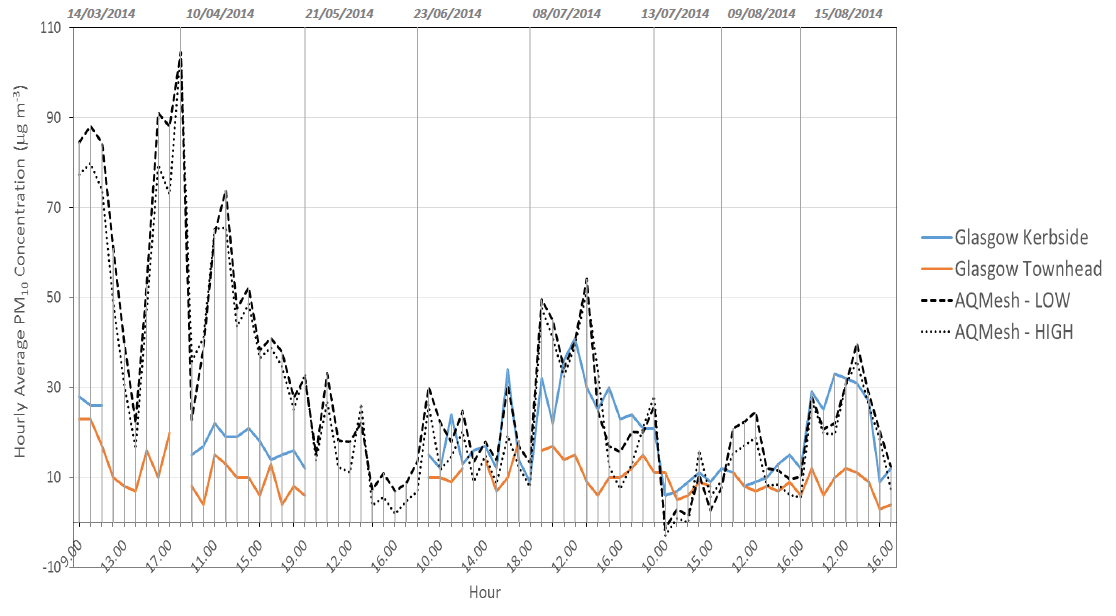
4.1.3 NO 2
Hourly mean NO 2 concentrations as measured at the fixed monitoring sites, Kerbside and Townhead, and by the mobile monitoring samplers during each mobile monitoring exercise are graphed in Figure 4.3. Minimum hourly mean NO 2 concentrations at Townhead and Kerbside were observed on the 13 th July (Sunday) with measured mean concentrations of 20 g m -3 and 9 g m -3 being reported at the sites respectively. In contrast, minimum hourly mean NO 2 concentrations were measured by the mobile monitoring trolley on the 9 th August (Saturday) with measured mean concentrations of 26 g m -3 and 29 g m -3 being reported at 0.80 m and 1.68 m, respectively.
Maximum hourly mean NO 2 concentrations at Townhead and Kerbside were measured on the 8 th July (Tuesday) and 15 th August (Friday) with measured mean NO 2 concentrations of 100 g m -3 and 39 g m -3, respectively. In comparison, maximum hourly mean NO 2 concentrations of 72 g m -3 and 89 g m -3 were measured by the mobile monitoring trolley at 0.80 m and 1.68 m on the 21 st May (Wednesday), respectively.
Over the entire duration of the monitoring study, a mean NO 2 concentrations of 56 g m -3 and 68 g m -3 was measured by the mobile monitoring trolley at a height of 0.80 m and 1.68 m, respectively. A mean NO 2 concentration of 25 g m -3 was recorded at the Glasgow Townhead fixed monitoring site and 63 g m -3 at Glasgow Kerbside. These data therefore suggest that average NO 2 concentrations measured at 1.68 m during the entire study duration were 5 g m -3 higher than the concentrations recorded at the Glasgow Kerbside. However, this relationship was not mirrored when the data from the mobile trolley at a height of 0.80 m was considered. At this lower height, the mean NO 2 concentrations recorded over the study duration were 7 g m -3 lower than those reported at Glasgow Kerbside.
Comparison of concentrations of NO 2 recorded by the monitoring trolley at both exposure heights over the entire study period was undertaken using orthogonal regression. The analyses utilised a total of 61 hourly average data pairs and recorded a mean absolute error ( MAE) of 4.72 g m -3 and a strong correlation (r 2) of 0.918. No data points were rejected in the Grubbs' outlier test. By application of the calculated slope of 1.314 and intercept of -6.798, and using the NO 2 annual mean objective level of 40 g m -3 as the basis for initial comparison, the analyses indicated that the hourly mean NO 2 concentration at 1.68 m is likely to be 46 g m -3, approximately 15% greater than that observed at 0.80 m. When the NO 2 hourly mean objective level of 200 g m -3 is used as the basis for comparison, the analyses indicates that the hourly mean NO 2 concentration at 1.68 m is likely to be 256 g m -3, 28% higher than the concentration observed at 0.80 m. Therefore in general, higher hourly mean NO 2 concentrations are likely to be measured at adult breathing height.
Figure 4.3 Hourly Average NO 2 Concentrations Time-series - Mobile vs Fixed
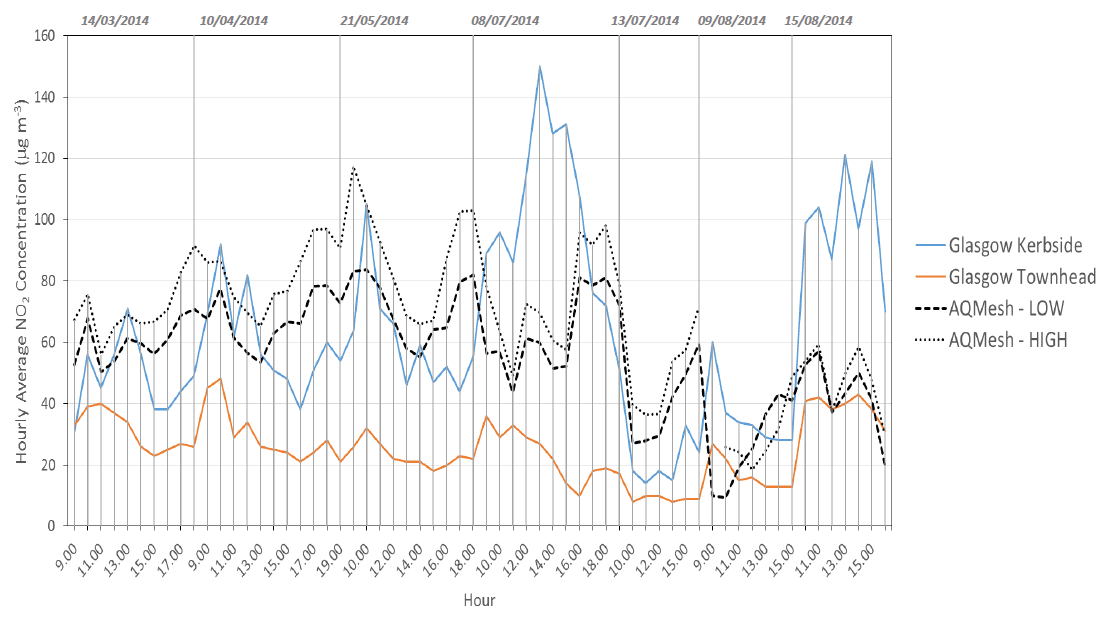
4.1.4 NO
Hourly mean NO concentrations as measured at the fixed monitoring sites, Kerbside and Townhead, and by the mobile monitoring samplers during each mobile monitoring exercise are graphed in Figure 4.4.
Minimum hourly mean NO concentrations at Kerbside and Townhead were observed on the 8 th July (Tuesday) and 13 th July (Sunday) with mean concentrations of 18 g m -3 and 1 g m -3 being reported on these days and at these sites, respectively. In contrast, minimum hourly mean NO concentrations were observed by the mobile monitoring trolley on the 21 st May (Wednesday) and 14 th March (Friday), with a measured mean concentration of 4 g m -3 being observed at both 0.80 m and 1.68 m. Maximum hourly mean NO concentrations of 321 g m -3 and 18 g m -3 were recorded at Kerbside and Townhead on the 8 th July (Tuesday), respectively. Maximum hourly mean NO concentrations were also observed by the mobile monitoring trolley on the 8 th July (Tuesday), with measured mean NO concentrations of 129 g m -3 and 154 g m -3 being reported at heights of 0.80 m and 1.68 m, respectively.
Over the entire study period, mean NO concentrations of 102 g m -3 and 7 g m -3 were recorded at Glasgow Kerbside and Glasgow Townhead, respectively. Mean NO concentrations of 54 g m -3 were measured by the mobile monitoring unit at both 0.80 m and 1.68 m. These data therefore suggest that NO concentrations were approximately 89% higher at the Glasgow Kerbside monitoring site higher than mean NO concentrations measured by the mobile monitoring site over the prescribed study period.
Comparison of concentrations of NO recorded by the monitoring trolley at both exposure heights over the entire study period was undertaken using orthogonal regression. The analyses utilised a total of 53 hourly average data pairs and recorded a mean absolute error ( MAE) of 11.47 g m -3 and a strong correlation (r 2) of 0.900. No data points were rejected in the Grubbs' outlier test. Both the slope of 1.036 and intercept of 2.490 are deemed insignificant using the criteria detailed in Section A1.3, Appendix A. Therefore, the data indicate that there is no significant difference in hourly mean NO concentrations measured at 0.80 m and 1.68 m.
Figure 4.4 Hourly Average NO Concentrations Time-series - Mobile vs Fixed
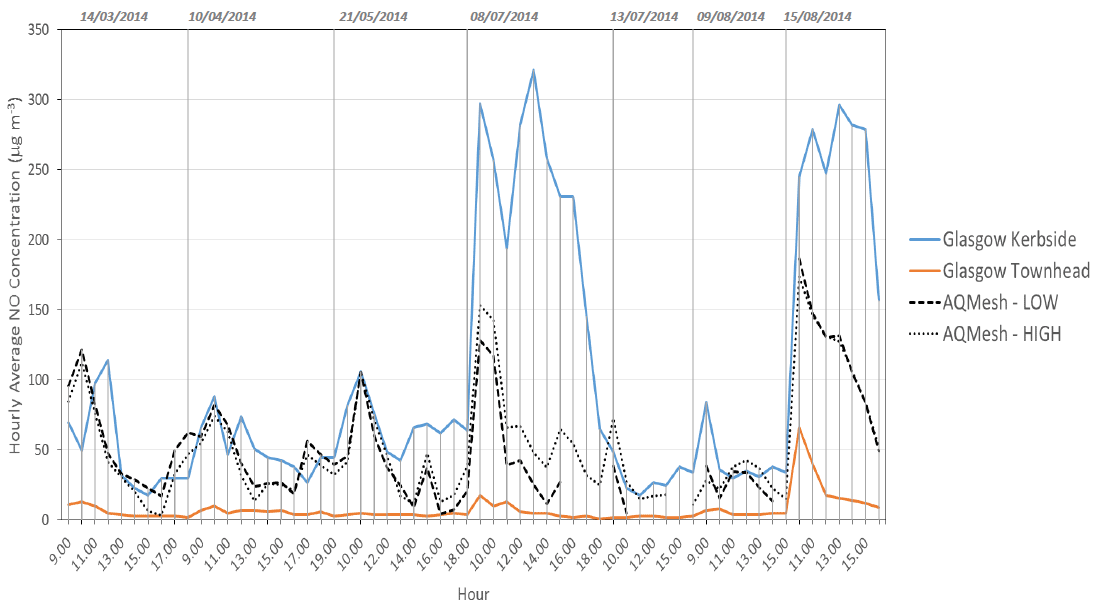
4.2 Pollutant Concentrations vs Height
In order to investigate the relationship between pollutant concentrations and height within different urban environments, points from 4 areas of the mobile monitoring route were selected for detailed analyses. The 4 areas selected for detailed analyses are summarised in Table 4.1. In addition to the entire route, these sections of the route were selected for separate analysis due to the environment types they are known to represent and also because it was anticipated that these sections would have some of the highest and lowest concentrations of pollutants due to the proximity of relevant sources and the opportunity for dispersion.
Table 4.1 Sections of Study Route selected for detailed analysis of the influence of exposure height on observed pollutant concentration
| Section of Route |
Description of street on route |
|---|---|
| Entire Study Route |
Representative of Glasgow City Centre |
| Hope Street |
Busy street canyon orientation south to north (partially restricted to buses & taxis) |
| Sauchiehall/ Buchanan Street |
Pedestrianised section of route - predominantly urban background in nature |
| High Street |
Busy urban street orientation north to south |
Figure 4.5 shows the sampling points by street used for the analyses, with all points for Glasgow City Centre shown previously in Figure 3.3; together with photographs of each street in Figure 4.6.
Figure 4.5 Sampling Points - Hope Street, High Street and Sauchiehall St/Buchanan St
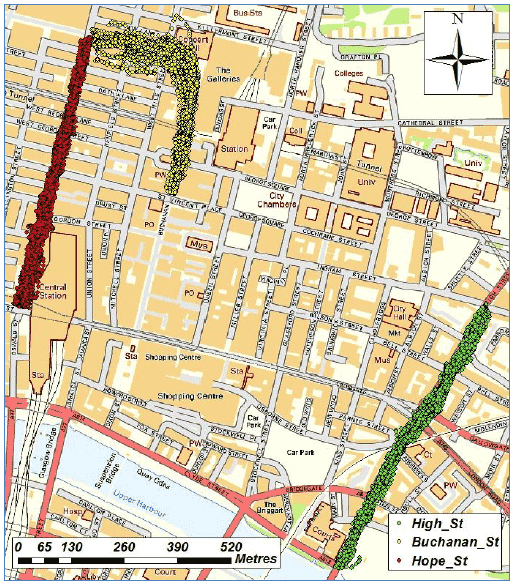
Contains Ordnance Survey data © Crown copyright and database right 2015
The Hope Street section was selected as it is a busy narrow street surrounded by high buildings and therefore fits the classic description of a street canyon where dispersion of pollutants is likely to be restricted (aspect ratio canyon width/building height) of between 1.5 and 2.5. Sections of Hope Street are also restricted to buses and taxis, and large volumes of these vehicles (approximately 120 buses per hour during the day) operate in this street on a daily basis [8] . The Sauchiehall and Buchanan Street sections of the route were selected as these are largely pedestrianised in nature and thus more representative of the urban background situation. The High Street section was selected as it is characterised by high traffic volumes in close proximity to the pavements. High Street is an A-Road (A8) and in 2013 Transport Scotland's automatic traffic counters reported an annual average daily traffic flow for this street of 14,520 vehicles [9] . Figure 4.7 provides details of the 2013 traffic composition from these counts which was largely dominated by cars.
Figure 4.6 Photographs - Hope Street, High Street (A8) and Buchanan Street
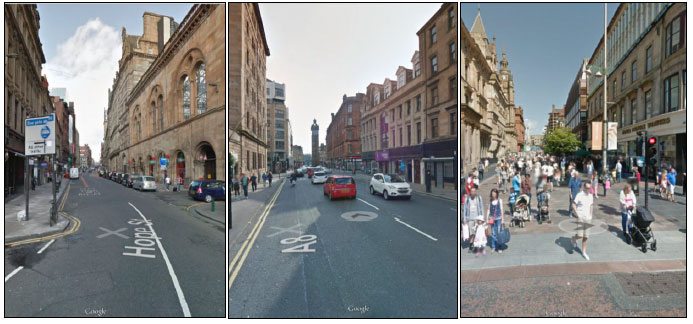
Figure 4.7 Traffic Composition - High Street, Glasgow 2013
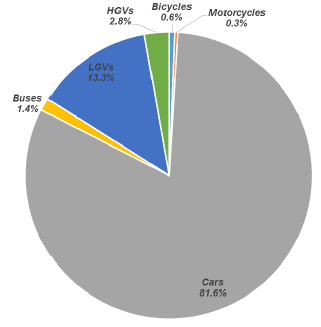
4.2.1 Glasgow City Centre
Full details of the orthogonal regression undertaken for each pollutant versus height over all sampling points are presented in detail in Appendix G. The resultant relationships identified between pollutant concentrations measured at 1.68 m ( C 1.68) and at 0.80 m ( C 0.80) are of the form:

Where c is the intercept of the regression line and d is the slope of the regression line. Again, if the slope and intercept are deemed significant then they are highlighted in red italic . Therefore, the following relationships between pollutant concentrations at 1.68 m and 0.80 m have been derived:
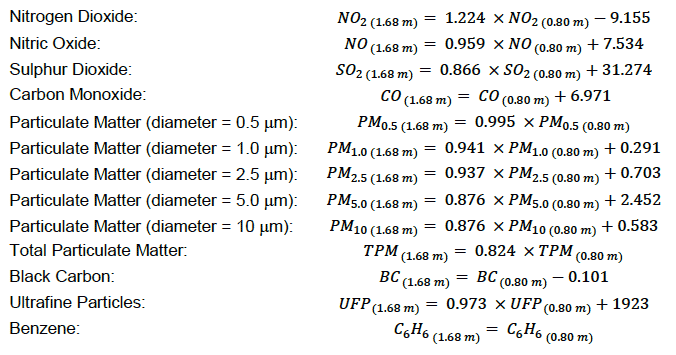
Table 4.2 Pollutant vs Height Regression Results - Glasgow Centre
| Pollutant |
1 minute |
Orthogonal Regression |
No of Data Pairs Rejected |
|||||||
|---|---|---|---|---|---|---|---|---|---|---|
| n bs |
MAE |
r 2 |
Slope (d) ± u d |
Intercept (c) ± u c |
||||||
| NO 2 |
3705 |
19.01 |
0.764 |
1.224 |
± |
0.010 |
-9.155 |
± |
0.873 |
22 (0.1%) |
| NO |
3629 |
27.15 |
0.781 |
0.959 |
± |
0.007 |
7.534 |
± |
0.619 |
98 (2.6%) |
| SO 2 |
3713 |
31.08 |
0.734 |
0.866 |
± |
0.007 |
31.274 |
± |
0.735 |
14 (0.4%) |
| CO |
3611 |
15.01 |
0.976 |
0.997 |
± |
0.003 |
6.971 |
± |
0.613 |
116 (3.1%) |
| PM 0.5 |
4101 |
0.14 |
0.991 |
0.995 |
± |
0.002 |
-0.005 |
± |
0.006 |
199 (4.6%) |
| PM 1.0 |
4162 |
0.34 |
0.987 |
0.941 |
± |
0.002 |
0.291 |
± |
0.012 |
138 (3.2%) |
| PM 2.5 |
4174 |
0.80 |
0.978 |
0.937 |
± |
0.002 |
0.703 |
± |
0.029 |
126 (2.9%) |
| PM 5.0 |
4244 |
2.89 |
0.942 |
0.876 |
± |
0.003 |
2.452 |
± |
0.110 |
56 (1.3%) |
| PM 10 |
4218 |
5.36 |
0.897 |
0.876 |
± |
0.004 |
0.583 |
± |
0.221 |
81 (1.9%) |
| TPM |
4195 |
7.31 |
0.843 |
0.824 |
± |
0.005 |
-0.292 |
± |
0.308 |
105 (2.4%) |
| BC |
4121 |
0.87 |
0.868 |
1.007 |
± |
0.006 |
-0.101 |
± |
0.026 |
209 (4.8%) |
| UFP |
4137 |
4129 |
0.877 |
0.973 |
± |
0.005 |
1923 |
± |
153 |
176 (4.1%) |
With the exception of NO 2, NO and SO 2, the majority of samplers showed strong correlations (r 2 > 0.80). NO 2, NO and SO 2 demonstrated moderately strong correlations (r 2) of 0.764, 0.781 and 0.734, respectively. The application of Grubbs' outlier test to the datasets resulted in rejection of between 0.1% (NO 2) and 4.8% ( BC) of data. The number of data-pairs included in the analyses ranged from 3611 for CO to 4244 for PM 5.0, and the calculated mean absolute error ranged from 0.14 g m -3 for PM 0.5 to 31.04 g m -3 for SO 2 and 4129 Particles cm -3 for UFP.
These data suggested that the difference in measured 1-minute average concentrations at 0.80 m and 1.68 m were pollutant specific. Most notably, for particulate pollutants, excluding UFP, the data indicated that higher concentrations were measured at 0.80 m and that the extent of the difference is dependent upon the size of the particulate particles measured. In general the results indicated that the larger the particle the greater the difference between concentrations measured at 0.80 m and 1.68 m. For gaseous pollutants and UFP, the data indicated that the opposite relationship is true with higher concentrations being measured at 1.68 m.
In terms of the concentrations defined by the air quality strategy ( AQS) objectives, Table 4.33 summarises the percentage difference in pollutant concentrations measured at 1.68 m relative to concentrations measured at 0.80 m. For example, if the percentage difference ( P) is 15%, then the pollutant concentrations measured at 1.68 m ( C 1.68) were 15% higher than that measured at 0.80 m. The following equation was used for this calculation:

As can be seen in Table 4.3, the data indicate that there is only a small difference between C 0.80 and C 1.68 at the CO running 8-hour mean objective concentration (10 mg m -3), the NO 2 annual mean objective concentration (40 g m -3), the PM 2.5 annual mean objective concentration (12 g m -3) and the SO 2 15-minute mean objective concentration (266 g m -3), with calculate percentage differences of 0.1%, -0.5%, -0.4% and -1.7%, respectively.
Measured concentrations of NO 2 and SO 2 were 17.8% and 11.6% higher at 1.68 m than 0.80 m at the NO 2 1-hour mean concentration of 200 g m -3 and the SO 2 24-hour mean concentration of 125 g m -3, respectively. In contrast, concentrations of PM 10 and SO 2 were 11.2%, 9.1% and 4.5% lower at 1.68 m than at 0.80 m when the PM 10 annual mean objective concentration of 18 g m -3, the PM 10 daily mean objective concentration of 50 g m -3 and the SO 2 1-hour mean objective of 350 g m -3 were used as the basis for analyses.
Table 4.3 Percentage Difference between Pollutant Concentrations at 0.80 m and 1.68 m in the Context of the Concentration Levels of the AQS Objectives - Glasgow City Centre
| Pollutant |
Air Quality Objective |
Percentage Difference Between 0.80 m and 1.68 m (P) High:Low |
|
|---|---|---|---|
| Concentration |
Measured as |
||
| Carbon Monoxide |
10 mg m -3 |
Running 8-hour mean |
0.1% |
| Nitrogen Dioxide |
200 µg m -3, not to be exceeded more than 18 times a year |
1-hour mean |
17.8% |
| 40 µg m -3 |
Annual mean |
-0.5% |
|
| Particulate Matter (PM 10) (Gravimetric) |
50 µg m -3, not to be exceeded more than 7 times a year |
24-hour mean |
-11.2% |
| 18 µg m -3 |
Annual mean |
-9.1% |
|
| Particulate Matter (PM 2.5) (Gravimetric) |
12 µg m -3 |
Annual mean |
-0.4% |
| Sulphur Dioxide |
350 µg m -3, not to be exceeded more than 24 times a year |
1-hour mean |
-4.5% |
| 125 µg m -3, not to be exceeded more than 3 times a year |
24-hour mean |
11.6% |
|
| 266 µg m -3, not to be exceeded more than 35 times a year |
15-minute mean |
-1.7% |
|
Summary statistics - minimum (Min), 2 nd quartile (2 nd Q), median (med), mean, 3 rd quartile (3 rd Q) and maximum (max) of 1-minute average concentrations over all mobile monitoring exercises, together with the percentage difference in measured concentrations at 1.68 m and 0.80 m (P) are detailed in Appendix L. Figure 4.1 summarises the percentage differences in measured pollutant concentrations at 0.80 m and 1.68 m as a function of the calculated summary statistics.
The data indicated that the difference in measured 1-minute average concentrations at 0.80 m and 1.68 m are pollutant or species specific. Most notably, for particulate pollutants, excluding UFP, the data indicated that higher concentrations are measured at 0.80 m and that the extent of the difference is dependent upon particle size, with the larger the particle the greater the difference between concentrations measured at 0.80 m and 1.68 m. For gaseous pollutants and UFP, the data indicate that the opposite is true with higher concentrations being measured at 1.68 m. No appreciable difference in PM 0.5 concentrations at 0.80 m and 1.68 m was identified.
Over the course of the study, the largest differences in concentrations measured at 0.80 m and 1.68 m were observed for TPM and SO 2, with TPM concentrations measured at 1.68 m observed to be 21.4% lower than that measured at 0.80 m. Conversely, average SO 2 concentrations measured at 1.68 m were 40.1% greater than that measured at 0.80 m. Little or no difference in the mean of 1-minute average pollutant concentrations at 0.80 m and 1.68 m was seen for BC, PM 0.5, PM 1.0, PM 2.5 and NO with calculated percentage differences of 0.7%, -0.2%, -1.2%, -2.3%, and 2.9%, respectively. The percentage difference between 0.80 m and 1.68 m at the mean of all measured 1-minute average concentrations was calculated to be -4.1%, -12.0%, 3.9%, 4.7% and 7.6% for PM 5.0, PM 10, CO, UFP and NO 2, respectively.
At the measured minimum, the greatest difference between concentrations measured at 0.80 m and 1.68 m was seen for PM 5.0 with a calculated percentage difference of 79.1%. Little or no difference between concentrations at 0.80 m and 1.68 m was seen for BC and PM 2.5 with calculated percentage differences of 1.6% and 0.7%, respectively. The percentage difference between 0.80 m and 1.68 m was -21.4% for TPM.
At the maximum concentrations observed by the mobile monitoring trolley, the most significant difference between concentrations measured at 0.80 m and 1.68 m was seen for TPM and NO 2 with calculated percentage differences of -19.4% and 15.9%, respectively. Little or no difference in the mean of 1-minute average pollutant concentrations at 0.80 m and 1.68 m was seen for UFP, BC, PM 0.5, and CO with calculated percentage differences of -2.4%, 0.7%, 0% and 0.2%, respectively. The percentage differences observed between 0.80 and 1.68 m were -5.9%, -6.1%, -13.5%, -14.0%, -3.9% and -10.2% for PM 1.0, PM 2.5, PM 5.0, PM 10, NO and SO 2. These findings therefore indicated that at the measured maximum concentrations of UFP, NO and SO 2 concentrations, higher concentrations were observed at 0.80 m than at 1.68 m, in contrast to what was observed at lower concentrations. This may be due to the maximum concentrations being measured when close by direct sources of these pollutants, in this case likely to be road traffic, are experienced. As the emission point of traffic sources is below 0.80 m in many cases and due to the mobile nature of the monitoring, pollutant may be measured at 0.80 m before they have dispersed fully to 1.68 m.
Figure 4.1 Summary Statistics vs Percentage Difference in Measured 1-minute Average Concentrations at 0.80 m and 1.68 m
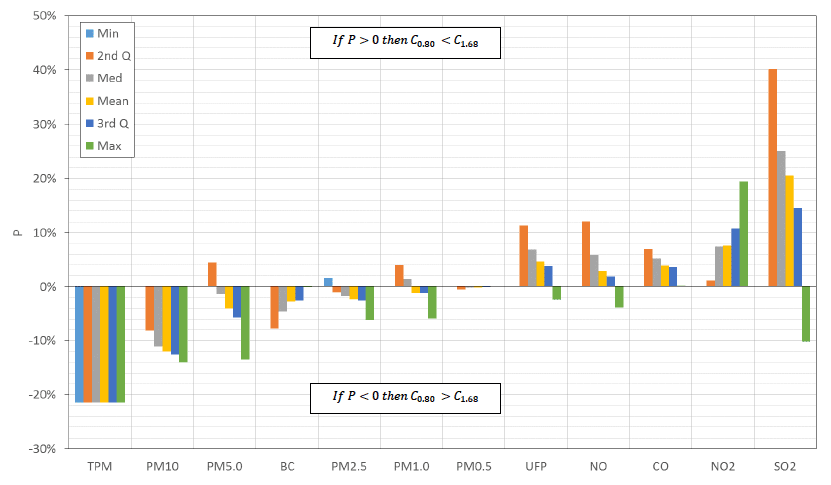
4.2.2 Glasgow City Centre - Benzene
Average benzene concentrations ranged from 0.22 g m -3 on 09/08/2014 at 0.80 m to 1.80 g m -3 on 23/06/2014 at 0.80 m. The average benzene concentrations measured over all exercises was 0.68 g m -3 and 0.71 g m -3 at 0.80 m and 1.68 m, respectively.
Orthogonal regression analysis of average benzene concentrations measured at 0.80 m versus 1.68 m was undertaken on a total of 6 data-pairs, giving a calculated mean absolute error of 0.10 g m -3 and strong r 2 value of 0.954. Two data pairs were identified as outliers and rejected. The slope of the regression line was calculated at 1.144 with an intercept of 0.006 g m -3, both of which have been determined as insignificant when compared to the associated uncertainties of 0.241 g m -3, and 0.147 g m -3, respectively. As a result, these results suggested that there was no significant difference between average benzene concentrations measured at 0.80 m and 1.68 m. However, it is appropriate to note that this monitoring study of benzene is limited and that additional monitoring would be required to confirm these results. Full details of the regression and data are provided in Appendix G.
4.2.3 Hope Street
Full details of the orthogonal regression results for each pollutant versus height along Hope Street, Sauchiehall St/Buchanan St and High St are detailed in Appendix I. In the context of the concentration levels defined by the AQS objectives, Table 4.4 summarises the percentage difference in pollutant concentrations measured at 1.68 m relative to concentrations measured at 0.80 m using the relationships derived from the regression analyses.
With the exception of NO 2 and SO 2, on the Hope Street route data for all other samplers showed strong correlations (r 2 > 0.80). NO 2 and SO 2 both exhibited moderately strong correlations (r 2) of 0.793, and 0.736, respectively. Application of Grubbs' outlier test to the datasets resulted in rejection of between 1.0% (PM 5.0) and 6.2% ( BC) of data. The number of data-pairs included in the analyses ranged from 740 for NO to 865 for PM 5.0. The calculated MAE ranged from 0.18 g m -3 for PM 0.5 to 29.90 g m -3 for SO 2 and 4413 Particles cm -3 for UFP.
As presented in Table 4.4 the data indicated that a small difference existed between C 0.80 and C 1.68 at the CO running 8-hour mean concentration (10 mg m -3), the NO 2 annual mean concentration (40 g m -3), the PM 2.5 annual mean concentration (12 g m -3) and the SO 215-minute mean concentration (266 g m -3); with calculate percentage differences of -1.4%, 2.5%, -0.5% and -2.8%, respectively. Concentrations of NO 2 and SO 2 were found to be 12.7% and 9.8% higher at 1.68 m than at 0.80 m when the NO 2 1-hour mean concentration of 200 g m -3 and the SO 2 24-hour mean concentration of 125 g m -3 were used for comparison. Concentrations of PM 10 and SO 2 were found to be 8.4%, 12.6% and 5.5% lower at 1.68 m than those reported at 0.80 m when the annual mean PM 10 Standard (18 g m -3), the daily mean PM 10 standard (50 g m -3) and the 1 hour mean SO 2 standard (350 g m -3) were used as the basis for comparison.
4.2.4 Sauchiehall Street/Buchanan Street
On the Sauchiehall Street/Buchanan Street section, with the exception of NO 2, SO 2 and BC, all other samplers showed strong correlations (r 2 > 0.80). NO 2, SO 2 and BC were found to exhibit moderately strong correlations, with r 2 vales of 0.786, 0.762 and 0.759, respectively. Applying Grubbs' outlier test to the datasets resulted in rejection of between 0.2% (PM 5.0) and 4.9% ( BC) of data. The number of data-pairs included in the analyses ranged from 364 for NO to 417 for UFP. The calculated MAE ranged from 0.12 g m -3 for PM 0.5 to 29.90 g m -3 for SO 2 and 4413 Particles cm -3 for UFP.
As can be seen in Table 4.4, the data for the Sauchiehall Street/ Buchanan Street section indicated negligible differences between C 0.80 and C 1.68 at the CO running 8-hour mean concentration (10 mg m -3) and the PM 2.5 annual mean concentration (12 g m -3) with calculate percentage differences of 0% and -2.0%, respectively. Concentrations of NO 2 and SO 2 were found to be 20.4% and 3.3% higher at 1.68 m than 0.80 m at the NO 2 1-hour mean concentration of 200 g m -3 and the SO 2 24-hour mean concentration of 125 g m -3, respectively. At the NO 2 annual mean standard (40 g m -3), annual mean PM 10 standard (18 g m -3), the PM 10 daily mean standard (50 g m -3), the 1 hour mean SO 2 standard (350 g m -3) and the SO 215-minute mean concentration (266 g m -3), concentrations of NO 2, PM 10 and SO 2 concentrations were found to be 4.8%, 6.2%, 11.3%, 8.3% and 6.3% lower at 1.68 m than at 0.80 m.
4.2.5 High Street
On the High Street section, with the exception of NO 2, NO, SO 2 and BC, all other samplers showed strong correlations (r 2 > 0.80). The NO 2, NO, SO 2 and BC samplers exhibited moderately strong correlations (r 2) of 0.770, 0.705, 0.744 and 0.7879, respectively. Applying Grubbs' outlier test to the datasets resulted in rejection of between 0% (SO 2) and 6.1% (PM 0.5) of data. The number of data-pairs included in the analyses ranged from 457 for CO to 534 for PM 10. The calculated MAE ranged from 0.10 g m -3 for PM 0.5 to 33.62 g m -3 for SO 2 and 3598 Particles cm -3 for UFP.
As can be seen in Table 4.4, the data indicated that a small difference was observed between C 0.80 and C 1.68 at the CO running 8-hour mean concentration (10 mg m -3), NO 2 annual mean concentration (40 g m -3), the PM 2.5 annual mean concentration (12 g m -3) and the SO 2 1-hour mean of 350 g m -3 with calculate percentage differences of 0.1%, 2.5%, 0.6% and 2.3%, respectively. Concentrations of NO 2 and SO 2 were found to be 20.4%, 20.6% and 5.5% higher at 1.68 m than reported at 0.80 m when the 1 hour mean NO 2 standard (200 g m -3), the 24 h mean SO 2 standard (125 g m -3) and the 15 min mean SO 2 standard (266 g m -3) were used for analyses. Concentrations of PM 10 were found to be 11.6% lower at 1.68 m than those reported at 0.80 m at both the annual mean PM 10 standard (18 g m -3) and the daily mean PM 10 standard (50 g m -3).
Table 4.4 Percentage Difference between Pollutant Concentrations at 0.80 m and 1.68 m in the Context of the Concentration Levels of the AQS Objectives - Hope St, Sauchiehall St/Buchanan St and High St
| Pollutant |
Air Quality Objective |
Percentage Difference Between 0.80 m and 1.68 m (P) High:Low |
|||
|---|---|---|---|---|---|
| Concentration |
Measured as |
Hope St |
Sauchiehall St/ Buchanan St |
High St |
|
| Carbon Monoxide |
10 mg m -3 |
Running 8-hour mean |
-1.4% |
0% |
0.1% |
| Nitrogen Dioxide |
200 µg m -3, not to be exceeded more than 18 times a year |
1-hour mean |
12.7% |
20.4% |
20.4% |
| 40 µg m -3 |
Annual mean |
2.5% |
-4.8% |
2.5% |
|
| Particulate Matter (PM 10) (Gravimetric) |
50 µg m -3, not to be exceeded more than 7 times a year |
24-hour mean |
-12.6% |
-11.3% |
-11.6% |
| 18 µg m -3 |
Annual mean |
-8.4% |
-6.2% |
-11.6% |
|
| Particulate Matter (PM 2.5) (Gravimetric) |
12 µg m -3 |
Annual mean |
-0.5% |
-2.0% |
0.6% |
| Sulphur dioxide |
350 µg m -3, not to be exceeded more than 24 times a year |
1-hour mean |
-5.5% |
-8.3% |
2.3% |
| 125 µg m -3, not to be exceeded more than 3 times a year |
24-hour mean |
9.8% |
3.3% |
20.6% |
|
| 266 µg m -3, not to be exceeded more than 35 times a year |
15-minute mean |
-2.8% |
-6.3% |
5.5% |
|
4.2.6 Filtered Concentrations
Further analysis of the relationship between pollutant concentrations at 0.80 m and 1.68 m was also carried out using 6 concentration ranges: data less than the measured 25 th percentile (<25 th%'ile); data less than the measured 50 th percentile (<50 th%'ile), data less than the measured 75 th percentile (<75 th%'ile), data greater than the measured 25 th percentile (>25 th%'ile)¸ data less than the measured 50 th percentile (>50 th%'ile) and data greater than the measured 75 th percentile (>75 th%'ile).
Figure 4.2 summarises the calculated percentage differences in pollutant concentrations at 0.80 m and 1.68 m using the filtered datasets. The vertical axis scaling has been adjusted for clarity and therefore differences of greater than +100% are not shown for NO and SO 2. A pattern can be seen with lower concentrations, from the minimum measured concentrations up to the 75 th%'ile concentration for each pollutant, showing a bias towards higher concentrations being experienced at 1.68 m than at 0.80 m. As the pollutant concentrations under investigation are increased to include data from the 25 th%'ile to the maximum, the bias switches to increased concentrations being measured at 0.80 m compared to 1.68 m. There are exceptions to this; SO 2 and CO were found not follow this pattern, with a bias for higher concentrations at 1.68 m throughout the concentration range. Also, both PM 10 and TPM indicated a bias for higher concentrations at 0.80 m throughout the concentration range.
Full details of the orthogonal regression results using these filtered concentration ranges are provided in Appendix H. It is important to note that where the r 2 is below 0.40, the relationships are mild. For example, this is the case for NO 2, SO 2, PM 5, BC and UFP data <25 th%'ile, which showed mild r 2 of 0.262, 0.273, 0.237, 0.311 and 0.394, respectively. Weak correlations were also seen comparing NO, PM 10 and TPM data, with r 2 of 0.087, 0.191 and 0.156, respectively. In general, lower r 2 were seen for the lower concentration ranges.
Figure 4.2 Percentage Difference in Filtered Concentrations (<25 th%'ile, <50 th%'ile, <75 th%'ile, >25 th%'ile¸>50 th%'ile¸>75 th%'ile) at 0.80 m and 1.68 m
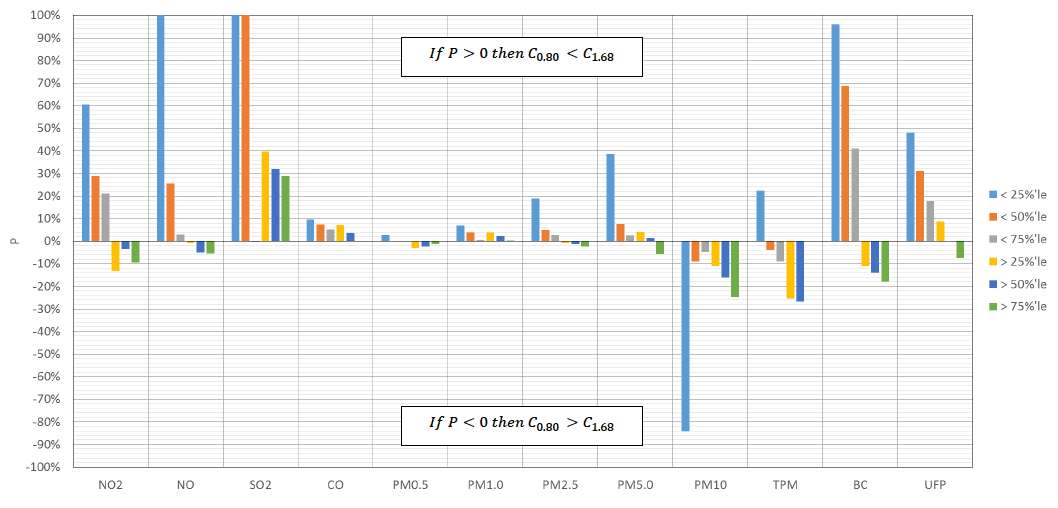
4.3 Meteorology
4.3.1 Wind Direction and Speed
During the study, data from a Met mast attached to the mobile monitoring trolley was used to monitor local variations in meteorology. However, following detailed analysis no clear conclusions could be drawn from the data and consequently the data is not discussed in detail within this report, but further information is presented in Appendix K. Data from Glasgow Airport was also observed during the monitoring study and is summarised below. During the eight days of sampling the 30 minute average wind speeds were between 2 and 11.7 m s -1, with the direction of the stronger winds primarily from a westerly direction, and the lighter winds all around the compass. This is illustrated in the wind rose in Figure 4.10 below.
Figure 4.10 Wind rose for 30 minute average wind speed and directions during the eight sampling days of the experiments (as recorded at Glasgow Airport)
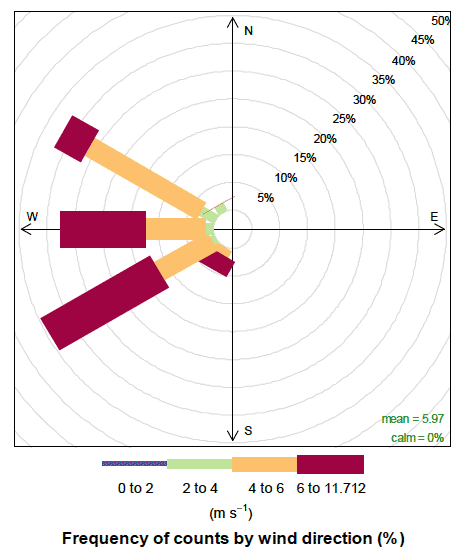
4.4 Cross-Pollutant Correlations
The following section reviews the correlations between pollutants using the 'corPlot' (Carslaw, 2014) function from the openair package. Matrices of the linear correlation coefficients between 1-minute average pollutant concentrations measured at 0.80 m and 1.68 m for each mobile monitoring exercise are shown in Appendix M.
Whilst differences were observed between individual mobile monitoring exercises, the following correlations can be identified:
- PM 0.5, PM 1.0, PM 2.5 show moderately strong to strong positive correlations.
- PM 2.5, PM 5.0 and PM 10 show moderately strong to strong positive correlations.
- The relationships between TPM with PM 2.5, PM 5.0 and PM 10 are inconsistent with moderate to strong positive correlations on 14/03/2014 (Fri), compared to weak to mild correlations on 13/07/2014 (Sun). This may be due to factors such as meteorological conditions combined with reduced traffic flows and therefore resulting in background particulate concentrations being the dominant source.
- Moderate to strong positive correlations can be seen between BC with NO, NO 2, SO 2, PM 0.5, PM 1.0, PM 2.5 and UFP, but again these relationships are inconsistent between monitoring exercises.
- Moderate to moderately strong negative correlations between NO 2 and SO 2 are apparent on 10/04/2014 (Thu), 21/05/2014 (Wed), 08/07/2014 (Tue) and 13/07/2014 (Sun).
- Moderate positive correlations between CO and SO 2 are apparent on 14/03/2014 (Fri), 21/05/2014 (Wed) and 13/07/2014 (Sun).
In addition to the correlations mentioned above, the data exhibited added complexity in that the observed relationships were shown to be inconsistent at 0.80 m and 1.68 m. For example on 23/06/2014 a moderately strong correlation was seen between UFP concentrations at 0.80 m and BC concentrations at 1.68 m with an r of 63%. However, this relationship was not seen between UFP at 0.80 m and BC at 0.80 m, UFP at 0.80 m and BC at 1.68 m, and UFP at 1.68 m and BC at 1.68 m with r of 31%, 25% and 40%, respectively. These findings indicated the extreme complexity of the intra-pollutant relationships.
4.5 Spatial Distributions of Pollutants
Contour plots of 1-minute average PM 2.5, BC and UFP concentrations throughout the mobile monitoring route at 0.80 m on 10/04/2014 are shown in Figure 4.11, Figure 4.42 and Figure 4.513, respectively. Contour plots of all measured pollutants are provided in Appendix N.
In general, increased pollutant concentrations were seen in areas were road traffic flow and congestion were elevated. In this case, this was observed along Hope Street, High Street and around George Square. Elevated concentrations of BC and UFP were more pronounced and visualised more clearly than other pollutants, perhaps indicating that road traffic may me the main local source for these pollutants. Concentrations of BC and UFP were found to decrease along Sauchiehall Street and Buchanan Street, however, this finding was not mirrored in PM 2.5 concentrations where increased concentrations were observed. These findings indicated a difference in sources for each pollutant or more likely in the way the pollutants disperse. Fugitive sources such as re-suspension of particulates may have a greater influence on the spatial variability of PM 2.5 concentrations.
Construction of the Strathclyde University Technology Innovation Centre at Albion Road was ongoing during the mobile monitoring exercises and higher concentrations of PM 2.5 and BC were clearly visible in this location. However, higher concentrations of UFP were not observed in the same area. It is considered that possible reasons for this could be that emissions from construction machinery may not be significant emitters of UFP with older diesel and petrol generators, for example, emitting coarser particles. There may also be significant fugitive emissions of particulate from mechanical processes, which again may consist primarily of coarser particles.
Figure 4.31 1-minute Average PM 2.5 Concentrations at 0.80 m - 10/04/2014 ( g m -3)
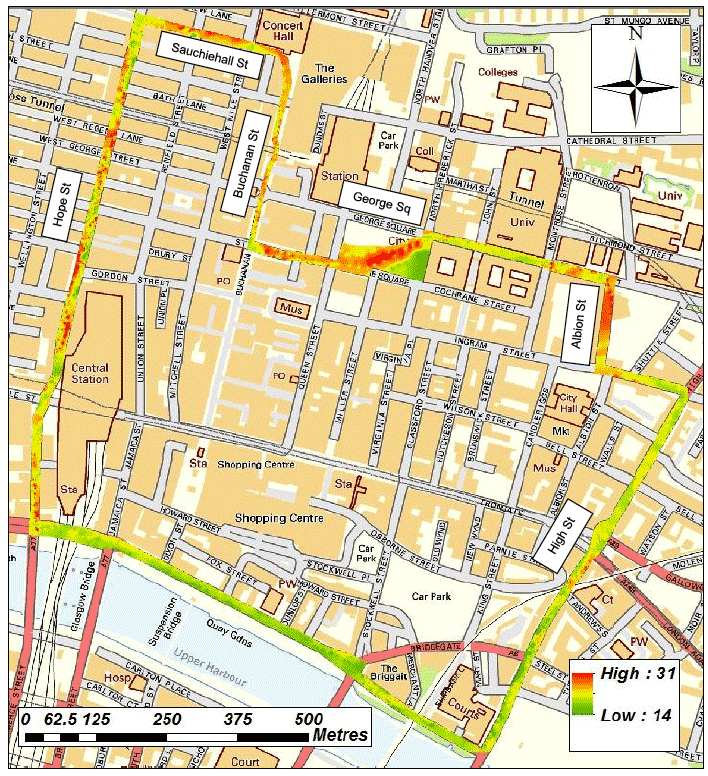
Contains Ordnance Survey data © Crown copyright and database right 2015
Figure 4.42 1-minute Average BC Concentrations at 0.80 m - 10/04/2014 ( g m -3)
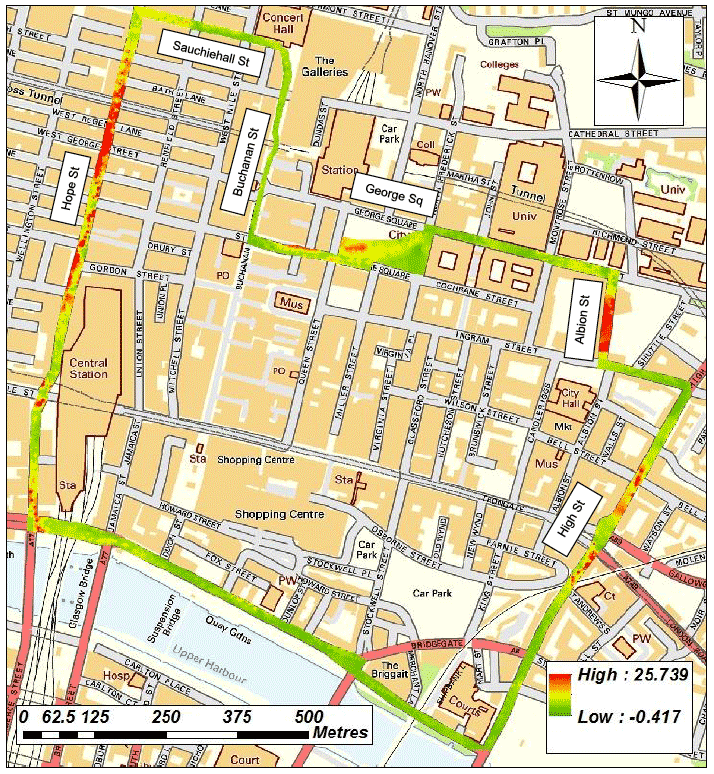
Contains Ordnance Survey data © Crown copyright and database right 2015
Figure 4.53 1-minute Average UFP Concentrations at 0.80 m -10/04/2014 (N Particles m -3)
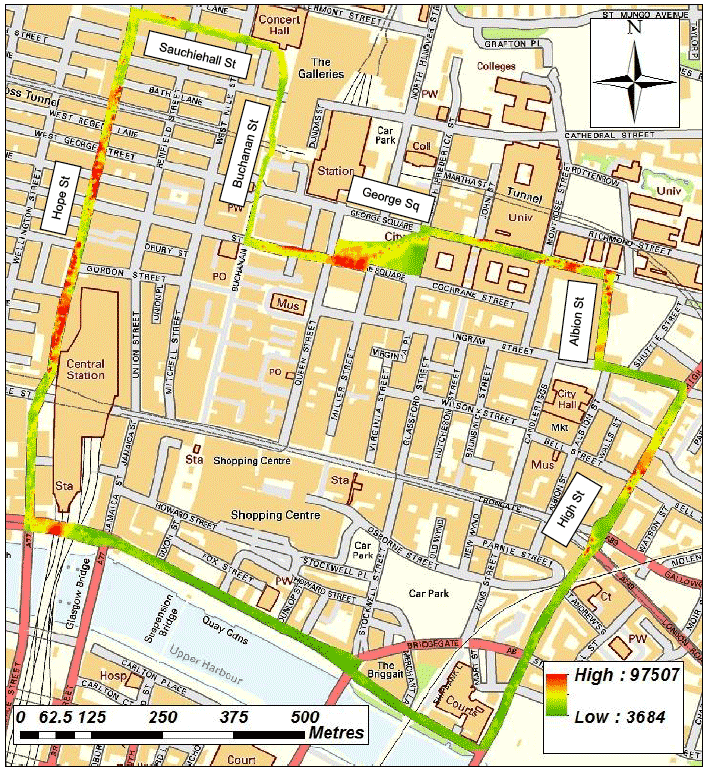
Contains Ordnance Survey data © Crown copyright and database right 2015
Contact
There is a problem
Thanks for your feedback